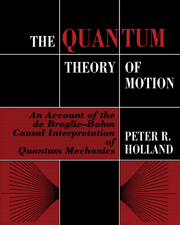 The Quantum Theory of Motion
The Quantum Theory of Motion Book contents
- Frontmatter
- Contents
- Preface
- 1 Quantum mechanics and its interpretation
- 2 Hamilton–Jacobi theory
- 3 Elements of the quantum theory of motion
- 4 Simple applications
- 5 Interference and tunnelling
- 6 The classical limit
- 7 Many-body systems
- 8 Theory of experiments
- 9 Spin ½: the Pauli theory
- 10 Spin ½: the rigid rotator
- 11 The Einstein–Podolsky–Rosen experiment and nonlocality
- 12 Relativistic quantum theory
- References
- Index
- Frontmatter
- Contents
- Preface
- 1 Quantum mechanics and its interpretation
- 2 Hamilton–Jacobi theory
- 3 Elements of the quantum theory of motion
- 4 Simple applications
- 5 Interference and tunnelling
- 6 The classical limit
- 7 Many-body systems
- 8 Theory of experiments
- 9 Spin ½: the Pauli theory
- 10 Spin ½: the rigid rotator
- 11 The Einstein–Podolsky–Rosen experiment and nonlocality
- 12 Relativistic quantum theory
- References
- Index
Summary
The frontispiece portrays a sequence of pictures in which a pattern reminiscent of the interference of waves is progressively built up by a series of individual events in which one electron at a time is sent through a two-slit interferometer and arrives at a detecting screen. Each event is unpredictable, yet over time a definite and reproducible pattern is formed. It is not just arbitrary. What causes the electrons to aggregate in this way? Is there some force acting on each individual electron as it passes through the device which impels it, on the average, to land in certain regions of the screen rather than others?
The historically dominant view in quantum mechanics regards this seemingly natural question as meaningless. For the query rests on the supposition that matter can be at least conceptually analysed, and that when we speak of an ‘electron’ we really mean an autonomous entity that can move in spacetime and be subject to forces. In contrast, it is generally asserted that our theoretical account of physics in the microdomain must stop short at predicting the likely outcomes when observations at the classical macroscopic scale are performed (the density of dots on the screen). That two electrons in the same quantum state appear at different points does not permit one to infer that they are, in fact, physically distinguished in some way. The uncertainty is postulated to be intrinsic to the system.
Information
- Type
- Chapter
- Information
- The Quantum Theory of MotionAn Account of the de Broglie-Bohm Causal Interpretation of Quantum Mechanics, pp. xvii - xxPublisher: Cambridge University PressPrint publication year: 1993